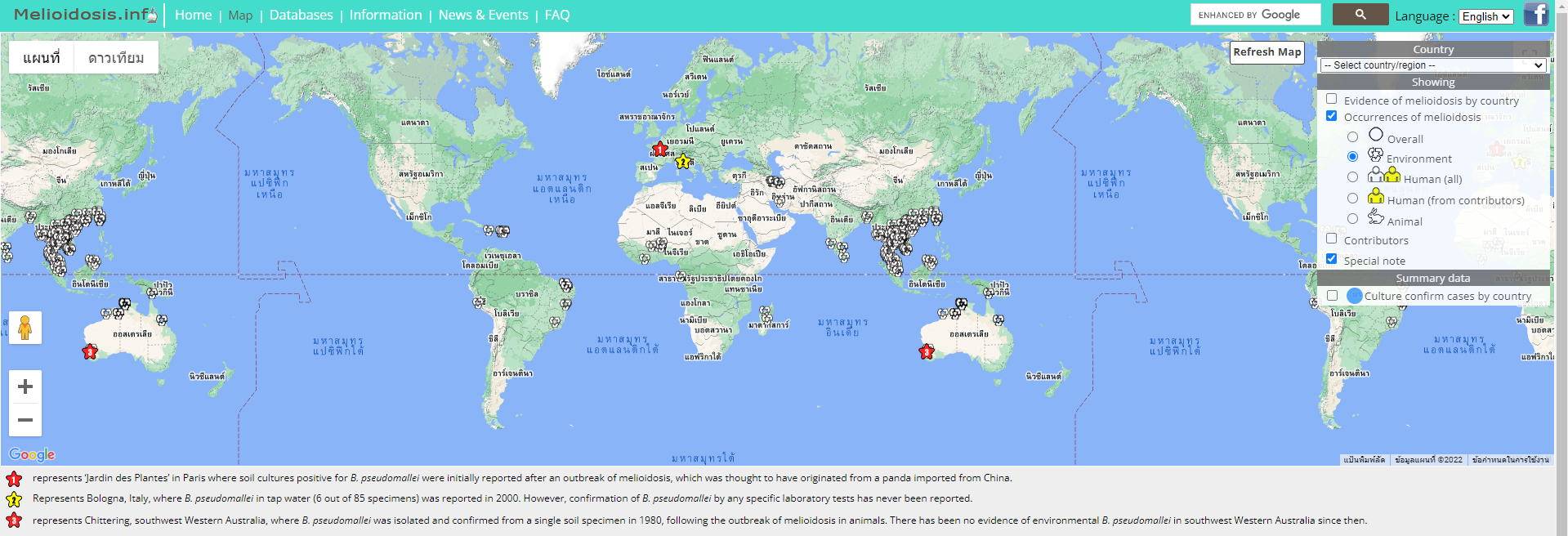Melioidosis in Italy
Gavin Koh
Direk Limmathurotsakul
Dear Gavin,
I did check that one when we did the ‘burden of melioidosis’ modelling paper (picture below).
It was excluded from the analysis. We note in the methods that we exclude unclear evidence.
It did not show in the main Figure in the paper. (There is no black dot in Italy)
(There is no black dot in France as well; as that one single study of environmental in ‘Jardin des Plantes’ was considered unclear).
On www.melioidlsis.info website ; map page. If users click ‘occurrence of melioidosis’ ; users can see our footnotes for details (picture below)
(we haven’t updated the map on the website for a while; so the US point hasn’t pop up yet and things in Australia need checking and updating as well)
(Nonetheless, I haven’t come across any new info that will change the situation for Italy [as Star and Footnote No 2] on the map).
We hope to have time to update the map on the website soon.
Kind regards,
Direk


--
You received this message because you are subscribed to the Google Groups "Melioidosis.info" group.
To unsubscribe from this group and stop receiving emails from it, send an email to
melioidosis...@googlegroups.com.
To view this discussion on the web visit
https://groups.google.com/d/msgid/melioidosis/CAKsZGzYC5GHCjG8oVF%3DioG7EBmAZq170VBTiGAgXJL5%3DB-W9pA%40mail.gmail.com.
Bart Currie
Sent: Saturday, October 22, 2022 1:40:59 PM
To: melio...@googlegroups.com <melio...@googlegroups.com>
Cc: Alberto Gaviraghi <582...@lstmed.ac.uk>
Subject: RE: [Melioidosis] Melioidosis in Italy
xiaqi...@sina.com
I totally agree with Professor Bart Currie.
发件人:Bart Currie <Bart....@menzies.edu.au>
收件人:"melio...@googlegroups.com" <melio...@googlegroups.com>
抄送人:Alberto Gaviraghi <582...@lstmed.ac.uk>
主题:Re: [Melioidosis] Melioidosis in Italy
日期:2022年10月22日 13点32分
David Dance
Dear Gavin et al.
I do remember this paper being published and I was very sceptical about it at the time, and still am. I think, as Bart and Direk have implied, that it is insufficient to rely purely on API 20NE for identification, particularly from non-clinical samples in a non-endemic area. I believe I wrote to the authors at the time in the hope that they might be able to make their isolates available for further study but never received a response, although I cannot locate the correspondence after all this time! Direk and I discussed whether or not to include this in his modelling analysis, as he describes below, and we decided to exclude it.
BW
David
To view this discussion on the web visit
https://groups.google.com/d/msgid/melioidosis/20221022075235.5552A2C0074%40webmail.sinamail.sina.com.cn.
David Dance
Dear Gavin et al.
I do remember this paper being published and I was very sceptical about it at the time, and still am. I think, as Bart and Direk have implied, that it is insufficient to rely purely on API 20NE for identification, particularly from non-clinical samples in a non-endemic area. I believe I wrote to the authors at the time in the hope that they might be able to make their isolates available for further study but never received a response, although I cannot locate the correspondence after all this time! Direk and I discussed whether or not to include this in his modelling analysis, as he describes below, and we decided to exclude it.
BW
David
From: <melio...@googlegroups.com> on behalf of "xiaqi...@sina.com" <xiaqi...@sina.com>
Reply to: "melio...@googlegroups.com" <melio...@googlegroups.com>
Date: Saturday, 22 October 2022 at 08:53
To: melioidosis <melio...@googlegroups.com>
Subject: 回复:Re: [Melioidosis] Melioidosis in Italy
To view this discussion on the web visit
https://groups.google.com/d/msgid/melioidosis/20221022075235.5552A2C0074%40webmail.sinamail.sina.com.cn.
Mark Mayo
Hello Gavin, I also agree with Bart and David comments about the API 20 NE results.
In this paper https://www.ncbi.nlm.nih.gov/pmc/articles/PMC2168515/ the accuracy was good, but Bp can have many different API 20 NE profiles, I found I had many different profiles as well from some of my earlier testing of Bp using API 20 NE.
Also the interpretation of some of the test results on the panel can lead to incorrect results or species identification. Some near neighbour species such as B.thailandensis can also be identified as Bp.
Unless as suggested they have the isolates for further testing to confirm the Bp identification, I would find it hard to call the isolates Bp based only on API 20 NE results.
Regards Mark
Mark Mayo,
Melioidosis Program Manager/Senior Researcher
Associate Deputy Director of Indigenous Leadership and Engagement
T: (08) 89 468 564
| F: (08) 89 468 464
| M: 0439 825 787
|
mark...@menzies.edu.au
|
www.menzies.edu.au
![]()
![]()
![]()
|
|
PO Box 41096, Casuarina NT 0811, Australia John Mathews Building (Bldg 58) | Royal Darwin Hospital Campus, Rocklands Drive, Casuarina NT 0810
|
In the spirit of respect, Menzies School of Health Research acknowledges the people and the Elders of the Aboriginal and Torres Strait Islander Nations who are the Traditional Owners of the land and seas of Australia.
To view this discussion on the web visit https://groups.google.com/d/msgid/melioidosis/CC37E1D6-1EDE-441D-8BC5-63AC5C2B11C8%40tropmedres.ac.
Bijayini Behera
To view this discussion on the web visit https://groups.google.com/d/msgid/melioidosis/SY4PR01MB54331BE718AF19C625EBEE74D82F9%40SY4PR01MB5433.ausprd01.prod.outlook.com.
Enoka Corea
Sent: Monday, October 24, 2022 3:53 AM
To: melio...@googlegroups.com <melio...@googlegroups.com>

